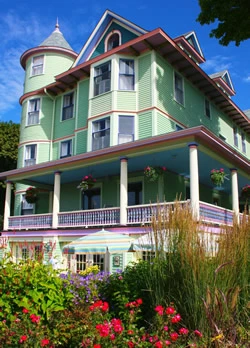Best Ways to Explore Mackinac Island’s History and Heritage
Exploring Mackinac’s Military and Colonial History
Introduction
Mackinac Island has a rich past filled with fascinating stories. It played a key role in military conflicts and colonial trade. The island was home to British, French, and American settlers. Exploring its history helps visitors understand its deep-rooted heritage.
This section covers Mackinac’s military forts and colonial sites. You will learn about Fort Mackinac, Colonial Michilimackinac, and Mackinac Island State Park. These sites provide insight into the island’s history.
Visit Fort Mackinac
One of the most well-known landmarks on the island is Fort Mackinac. It provides stunning views of the island from its cliffside location. The British built the fort in 1780 during the American Revolution. Later, it became an important U.S. military base.
What to Expect at Fort Mackinac
Visitors can explore well-preserved stone buildings inside the fort. Each building has exhibits that showcase life in the 18th and 19th centuries. The museum displays weapons, uniforms, and personal stories of soldiers.
One of the best experiences is the daily reenactments. Staff members dress as soldiers and demonstrate rifle firings. They also perform cannon blasts, just like in the past. These live displays make history come alive for visitors.
Must-See Highlights
- The Soldiers’ Barracks – Learn about the daily life of soldiers.
- The Post Hospital – See how medical treatments worked in the 1800s.
- The Tea Room – Enjoy a meal while overlooking the Straits of Mackinac.
Tips for Visiting
- Arrive early to catch the first demonstrations.
- If you plan to walk inside the fort, wear comfortable shoes.
- For information about special exhibits, consult the event schedule.
A visit to Fort Mackinac offers a hands-on history lesson. It is an unforgettable experience for history lovers.
Explore Colonial Michilimackinac
Colonial Michilimackinac is a reconstructed 18th-century fort. For the British and French, it was a significant commercial post. Fur traders, soldiers, and Native Americans lived and worked here. Today, visitors can explore this living history site.
Why It’s Important
This site played a key role in North American trade. The French built it in 1715 as a military and trading hub. It later became a British fort before being abandoned in 1781. Archaeologists have worked for decades to restore the site.
Things to See and Do
- Historic Buildings – Walk through homes, stores, and military quarters.
- Live Demonstrations – Watch blacksmiths and fur traders at work.
- Interactive Exhibits – Try hands-on activities like fire-starting and musket loading.
Events and Reenactments
During summer, costumed interpreters bring history to life. They show how people lived, cooked, and traded centuries ago. The site also hosts battle reenactments from the French and Indian War.
Visitor Tips
- Plan at least two hours to explore everything.
- Ask guides about ongoing archaeological digs.
- Visit in the summer for the best experience.
Colonial Michilimackinac offers a unique journey into the past. It is a must-visit for anyone interested in early American history.
Walk Through Mackinac Island State Park
Over 80% of the island is in Mackinac Island State Park. It contains historical treasures in addition to being a natural wonder. The park was established in 1895, making it Michigan’s first state park.
Historical Landmarks in the Park
The park is home to many sites with deep historical roots.
- Arch Rock – A stunning limestone arch with ties to Native American legends.
- Skull Cave – Native Americans and early fur traders frequented this tiny cave.
- Fort Holmes – During the War of 1812, a wooden fort was constructed.
Each location tells a unique part of Mackinac’s history. Visitors can hike, bike, or take a carriage ride to explore them.
Best Trails for History Lovers
- Arch Rock Trail – A scenic path leading to one of the island’s best views.
- Fort Holmes Trail – A short but steep hike to a historic fort.
- Native American Trail – Learn about Indigenous history while enjoying nature.
Tips for Exploring the Park
- Wear comfortable walking shoes.
- Bring a camera for beautiful historic sights.
- Visit early in the morning for fewer crowds.
Mackinac Island State Park is the perfect blend of nature and history. It offers a peaceful yet educational experience for all visitors.
Discovering Architectural and Cultural Heritage
Mackinac Island is not just about forts and battles. It has a rich architectural and cultural history. Beautiful buildings, charming streets, and traditional transport make it unique. This section explores three must-visit places.
Tour the Grand Hotel
One of Mackinac Island’s most well-known landmarks is the Grand Hotel. It opened in 1887 and became a symbol of luxury. Many famous people, including presidents, have stayed here. The hotel is renowned for both its historic charm and its magnificent architecture.
Why It’s Special
At 660 feet, the Grand Hotel boasts the longest porch in the world. It provides breathtaking views of the Mackinac Straits. The interior is full of antique decor and elegant chandeliers.
Things to Do
- Take a Self-Guided Tour – Discover the grounds and opulent halls.
- Enjoy Afternoon Tea – A classic tradition with delicious treats.
- Visit the Cupola Bar – A great spot for views and relaxation.
Tips for Visitors
- Non-guests pay a small fee to tour the hotel.
- Dress code applies in some areas during evening hours.
- To avoid big crowds, go in the early.
The Grand Hotel is a must-see for architecture lovers. It provides a window into the island’s affluent history.
Visit Historic Downtown Mackinac
Downtown Mackinac Island is full of history. The streets still have 19th-century buildings. The area has preserved its old-world charm with no cars allowed. Visitors can explore shops, museums, and historic homes.
Key Historic Sites
- Biddle House – One of the oldest houses on the island.
- McGulpin House – An intact house from the 18th century.
- Mission Church – The oldest church structure still standing in Michigan.
What to Do Downtown
- Take a Walking Tour – Ask local guides about the history of the island.
- Visit the Richard & Jane Manoogian Art Museum – See artwork related to Mackinac.
- Explore Local Shops – Find handcrafted souvenirs and historic books.
Tips for Exploring Downtown
- Early mornings are less crowded for exploring.
- When walking on cobblestone streets, wear shoes that are comfy.
- Visit the visitor center to obtain information and maps.
Downtown Mackinac Island offers a perfect mix of history and charm. You can experience life from millennia ago there.
Experience a Horse-Drawn Carriage Tour
Mackinac Island has banned cars since 1898. Instead, horse-drawn carriages are used for transportation. Riding in a carriage feels like stepping back in time.
Why Carriages Are Important
Carriages help preserve the island’s historic feel. They provide a leisurely means of island exploration. Drivers share interesting stories about Mackinac’s history.
What to Expect on a Tour
- A Slow-Paced Journey – Enjoy scenic views at a relaxed pace.
- Historic Stops – Visit places like Fort Mackinac and Grand Hotel.
- Knowledgeable Guides – Learn unique facts about the island’s past.
Tips for a Great Experience
- Book tickets early during peak seasons.
- Bring a light jacket for cooler weather.
- Ask questions! The guides love to share history.
A horse-drawn carriage tour is a memorable way to see Mackinac. In a certain way, it makes history come to life.
Embracing Mackinac’s Indigenous and Living History
Mackinac Island has deep ties to Native American culture. Long before European settlers arrived, Indigenous tribes lived here. Their traditions, legends, and influence remain part of the island’s history. Native American legacy can now be explored by tourists through cultural events, museums, and displays.
This section highlights key places and experiences that honor Mackinac’s Indigenous roots and living history.
Discover Native American Heritage
Native American tribes, especially the Anishinaabe (Odawa, Ojibwa, and Potawatomi), lived on Mackinac Island for centuries. The island was a sacred place and an important trade hub.
Key Sites and Exhibits
- Mackinac Island Native American Museum – Features artifacts, artwork, and historical displays.
- Arch Rock – A site with deep spiritual significance to Indigenous tribes.
- Skull Cave – Native Americans and later fur traders used this shelter.
Cultural Traditions and Stories
- The Anishinaabe word “Michilimackinac” is the source of the island’s name.
- Legends tell of a great turtle spirit that shaped the island.
- Traditional crafts like beadwork and birchbark canoes are displayed in museums.
Tips for Learning More
- Visit the Mackinac State Historic Parks website for exhibit details.
- Ask park rangers about Native American history during tours.
- Read informational plaques at historic sites.
Mackinac’s Indigenous heritage adds depth to its historical importance. Understanding these traditions enriches the visitor experience.
Participate in Special Events and Festivals
Mackinac Island hosts several events that bring history to life. These festivals celebrate the island’s past through reenactments, storytelling, and cultural performances.
Annual Historical Events
- Mackinac Island Lilac Festival – Features parades, music, and traditional crafts.
- Fort Mackinac Reenactments – Soldiers dress in 18th-century uniforms and perform drills.
- Mackinac Island Fudge Festival – Highlights a famous island tradition that dates back centuries.
Why Attend These Events?
- Experience history in a fun and interactive way.
- Watch live demonstrations of historical activities.
- Learn about Mackinac’s traditions from local experts.
Tips for Planning a Visit
- Check event schedules before booking a trip.
- Arrive early to get the best viewing spots.
- Dress for the weather, as events are often outdoors.
Festivals and reenactments bring Mackinac’s past to life. They provide a special means of engaging with the island’s past.
Conclusion
Mackinac Island’s history is more than just forts and old buildings. Its Indigenous roots and cultural traditions shape its identity. Visitors can explore Native American history, attend festivals, and experience living history.
This journey through Mackinac’s past shows why preserving heritage is important. Whether through museums, stories, or events, history remains alive on the island. A visit here is more than a trip—it is a step back in time.
Category: Mackinac Island


